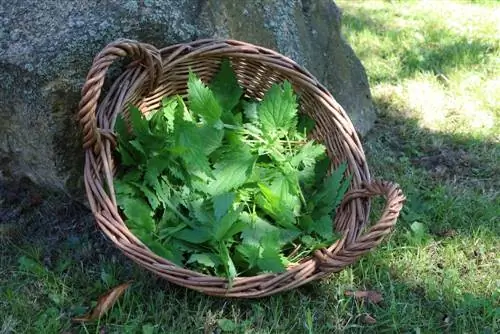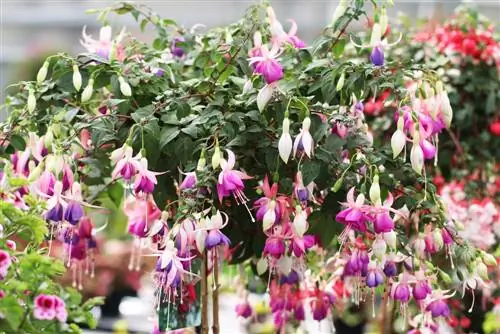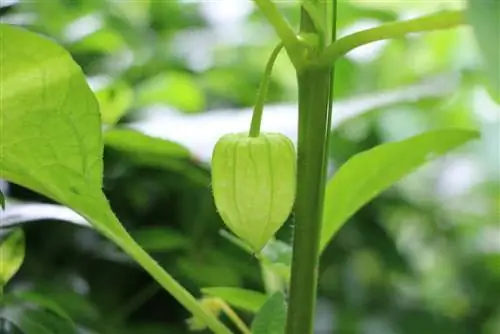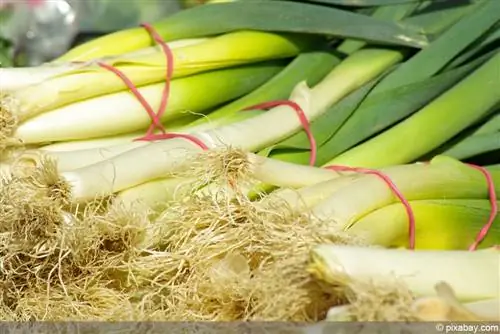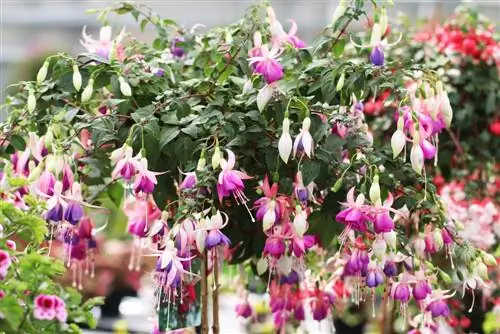- Author admin [email protected].
- Public 2023-12-17 03:39.
- Last modified 2025-01-24 12:45.
Houseplants are often infested with mites when the air in the room is too dry, especially in the winter months when there is too much warm heating air. A bowl of water is usually enough to quickly humidify the air and you have to spray the plants with water to prevent or get rid of mites. But garden plants are also sprayed if they have been attacked by pests or fungi. There are also preventative spraying measures with biological agents that you can make yourself.
Spraying houseplants with water
Houseplants need special and more frequent attention, especially in winter. Heating air that is too dry causes them a lot of trouble. Their leaves dry out more quickly and easily and their resistance decreases. Of course, pests such as mites or mealybugs have an easy time of it. To ensure that your houseplants stay he althy and are not attacked by these insects, it is extremely important that you dust the leaves of the plants and then spray them with lime-free water. A standard spray bottle, which can be purchased at any gardening store, is ideal for this purpose. The water temperature should not be too low, but not too warm either. The water should be at a comfortable temperature. Place foil or newspaper under the plant pots to prevent the surface from getting wet.
Do not spray in direct sunlight
Do not spray your houseplants when they are exposed to sunlight, especially the plants on the windowsills, so that they do not suffer from sunburn. It is better if you spray the plants either in the early morning hours or in the evening.
Tip:
Don't get too close to the plants when spraying, but rather produce a fine mist over them. Alternatively, hard-leaved plants can also be showered in the bathtub.
Spraying garden plants
Many garden plants such as roses, perennials, ornamental and berry bushes as well as fruit trees are sprayed with plant strengtheners in the spring before their flowers or fruit set. In technical terms, this is called shoot spraying. This spray protects the plants from pests and diseases and at the same time strengthens them for strong growth and good fruit setting. Spraying is carried out with commercially available or self-prepared plant strengthening preparations, which, depending on the situation, may contain proteins, whey, potash, algae extracts, essential oils, plant hormones, chalk or rock powder.
Tip:
You should also not spray garden plants when the sun is shining, otherwise their leaves will burn. Here it is also advisable to spray in the early morning hours or in the evening.
Never spray flowers
Whether you're spraying houseplants or garden plants, skip the flowers and spray only the leaves. Otherwise the flowers will become stained and can rot quickly.
Biological sprays for indoor and garden plants
There are many means and options with which you can spray plants organically:
Neem oil
For example, neem oil is commercially available together with a vegetable emulsifier, so that you only have to dilute the mixture with water to get a solution that is ready to spray. The concentration always depends on which plants you are spraying. Many hard-leaved house and garden plants tolerate a 1% solution. However, you should only spray soft-leaved plants with a 0.5 solution.
Usage
Neem oil reactivates the self-healing powers of plants and is an environmentally friendly remedy against harmful insects such as aphids, spider mites, mealybugs and others. Leaves gain a he althy shine.
Stinging nettle manure
The nettle manure is prepared in a vessel that can be made of earthenware, wood or plastic, but must never be made of metal in order to avoid undesirable reactions during the fermentation process.
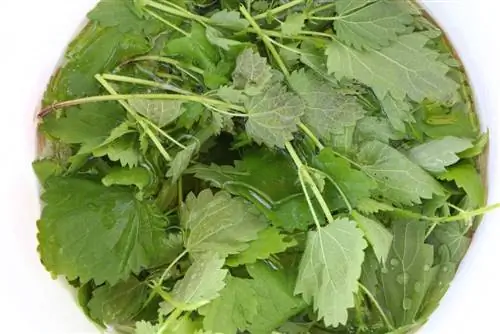
Apply
- 10 kg fresh nettles (cut before or during flowering) - alternatively 0.5 to 1 kg dried herb
- Let the nettle herb wilt briefly and chop it up
- Add 50 l of water (preferably rainwater)
- Cover the vessel with a grid
- stir once a day
- Add handful of stone powder to prevent unpleasant smells
- Finished when it stops foaming
- depending on the weather after approx. 2 to 3 weeks
As soon as the manure is ready, it is diluted with water, at least in a ratio of 1:10.
Usage
Nettle manure supplies mainly nitrogen and can be sprayed to strengthen and promote growth on almost all plants, especially flowers, fruit and vegetable plants, except garlic, onions, beans and peas. Spraying after flowering increases the yield of fruit trees and berry plants. The smell of the diluted nettle manure keeps lice and spider mites away.
Tip:
Since nettle contains iron, its manure can be sprayed on plants with chlorosis. To do this, it is sprayed onto the shoots before the buds break out.
Nettle cold water extract
- is prepared like nettle manure
- 1 kg nettles (preferably fresh) in 5 liters of water
- only leave it for a maximum of 24 hours
- must not ferment
- can be used undiluted
Usage
In addition to being used as a foliar fertilizer, the nettle cold water extract works excellently against initial aphid infestations.
Oak Leaves Cold Water Extract
For this extract, the oak leaves that fall in autumn and some bark are used and mixed. The mixture should weigh approximately 1kg. Mix the leaves and bark mixture with 10 liters of water and let stand for 12 to 24 hours. The approach must not ferment. Then dilute to 1:5 to 1:10.
Usage
The oak leaf cold water extract is used particularly in greenhouses against fungal infestation and sucking insects. Always spray cucumber leaves carefully as they are very large and thin!
Canadian goldenrod tea (Solidago canadensis)
Pour boiling water over a handful of goldenrod herb and let it steep for about an hour.
Usage
Goldenrod tea is used as a preventive measure against downy mildew and powdery mildew. It is also said to help against late blight on tomatoes and potatoes. Spray on the plants at least once a week.
Field horsetail broth
- 1 kg fresh (or 159 g dried)
- Fill up 10 liters of water
- Let it steep for 24 hours
If you don't have a large amount of horsetail on hand or don't want to use it as much, you can also add 15 g of dried herb (for example horsetail tea from the pharmacy) to 1 liter of water and let it stand for 24 hours. The broth is then simmered on a low flame for about 30 minutes. The liquid then has to cool down and is only diluted 1:5 when it has cooled down.
Usage
Field horsetail contains a lot of silica, which is particularly helpful against fungal diseases such as downy and powdery mildew, late blight, scab and gray mold. It is also used as a preventive measure against mites and to combat them.
Dandelion tea
For dandelion tea you need 150 g of dandelion leaves for 1 liter of boiling water.
Usage
Cooled and undiluted, spray on the plants preferably in spring. This regulates their growth. Above all, the fruit quality of fruit and berry bushes is improved.
Compost tea
To make compost tea, half a bucket of fresh compost is poured with rainwater. Then 3 spoons of rock dust and a little sugar (approx. 5g per liter) are added. Mix everything well and place the bucket in a warm place with a temperature of 20 to 25 °C. Stir well twice a day. The tea is strained after a week and diluted 1:10 with rainwater.
Usage
The compost tea helps against powdery mildew, potato late blight, brown rot and gray mold. The plants are sprayed dripping wet once a week.
Conclusion
Plant care also includes ensuring that the plant environment in the house has the appropriate humidity. This desire of the plants can be easily fulfilled with water that is regularly sprayed onto their leaves. Diluted plant strengtheners can also be sprayed on, which also act against pests, especially on perennials, roses, vegetable and fruit plants. However, you should not spray on felty leaves or flowers.

